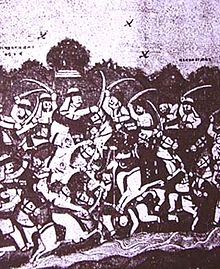Battle of Bhuchar Mori
| Battle of Bhuchar Mori | |||||||||
|---|---|---|---|---|---|---|---|---|---|
 Sketch from the Yaduvanshprakash by Mavdanji Ratnu, 1934 |
|||||||||
|
|||||||||
| Mughal Empire |
Nawanagar State Junagadh State Kundla State Cutch State |
||||||||
| Mughal Empire |
Nawanagar State Cutch State Okha Muli State |
||||||||
| Commanders and leaders | |||||||||
| Mirza Aziz Koka | |||||||||
| Strength | |||||||||
|
|
||||||||
| Casualties and losses | |||||||||
|
|
||||||||
| The numbers are derived from agreement of various sources. | |||||||||
|
|
|||||||||
The Battle of Bhuchar Mori, also known as Battle of Dhrol, was fought between the army of Kathiawar led by Nawanagar State and the Mughal army at Bhuchar Mori plateau near Dhrol, Saurashtra (now in Jamnagar district, Gujarat, India). It was meant to protect Muzaffar Shah III, the last Sultan of Gujarat Sultanate who had taken asylum under Jam Sataji of Nawanagar after his escape from the Mughal emperor Akbar. It was fought in July 1591 (Vikram Samvat 1648). The Kathiawar army included the armies of Junagadh and Kundla who betrayed Nawanagar and joined the Mughal army at last. The battle led to large number of casualty on both sides. The battle resulted in the decisive victory of Mughal army.
It is considered the largest battle in the history of Saurashtra. It is often dubbed as the of Saurashtra.
Muzaffar Shah III, the Sultan of Gujarat Sultanate was a titular king and the state was managed by various nobles in divisions who were in constant fight with each other. Muzaffar besieged Ahmedabad with help of other nobles. Itimad Khan, the noble managing Ahmedabad, invited Mughal emperor Akbar to conquer the state. He entered Ahmedabad without a battle on 18 November 1572. Muzaffar was captured hiding in a grain field. Akbar captured the state gradually by 1573 AD (Vikram Samvat 1629). His governors managed the state from 1573 to 1583 with frequent rebellions and disturbances.
Akbar jailed Muzaffar in Agra but he escaped to Gujarat in 1583 AD (Vikram Samvat 1639). After a short stay at Rajpipla, he crossed over to Kathiawar where he was joined by 700 soldiers. He was aided by Jam Sataji of Nawanagar, Daulat Khan of Junagadh and Khengar, the Jagirdar of Sorath. He raised an army from them of 30,000 cavalry and 20,000 infantry. He plundered villages near Ahmedabad and later captured Ahmedabad and eventually Vadodara and Bharuch. Muzaffar was defeated at Ahmedabad by new Mughal governor Mirza Khan in 26 January 1584 AD. Muzaffar fled to Mahemdabad and later to Khambhat. As Mirza Khan advanced towards Khambhat in February 1584, he moved to Vadodara where again both forces clashed and Muzaffar was defeated. He fled to mountains. Later when Bharuch was captured by the Mughal, he fled from place to place; first to Idar and later to Kathiawar. As nobody gave him asylum, Jam Sataji of Nawanagar State agreed and hid him in Barda Hills.
...
Wikipedia


